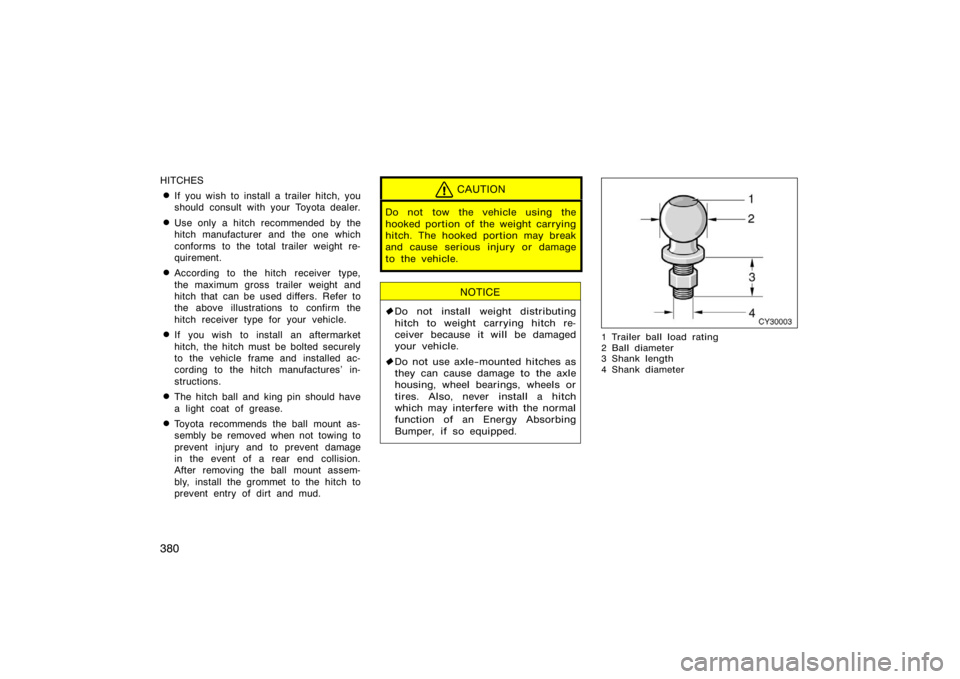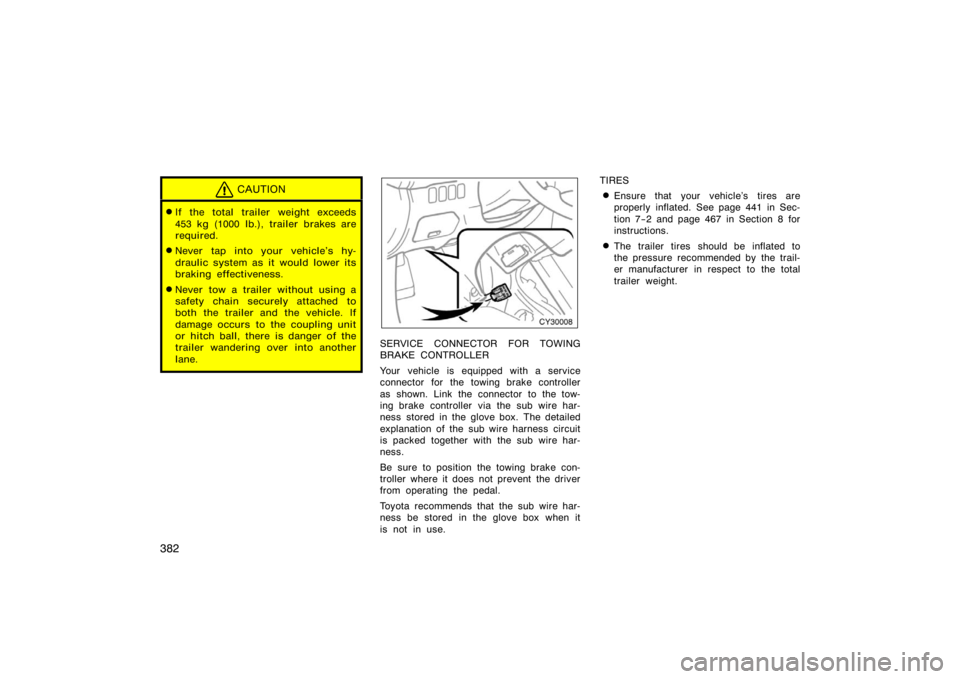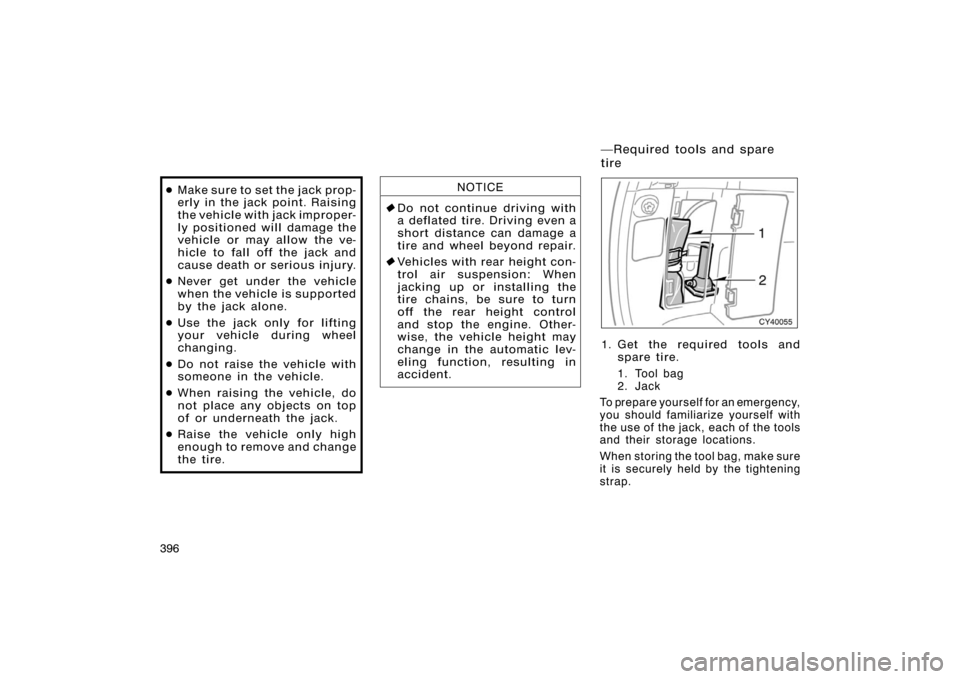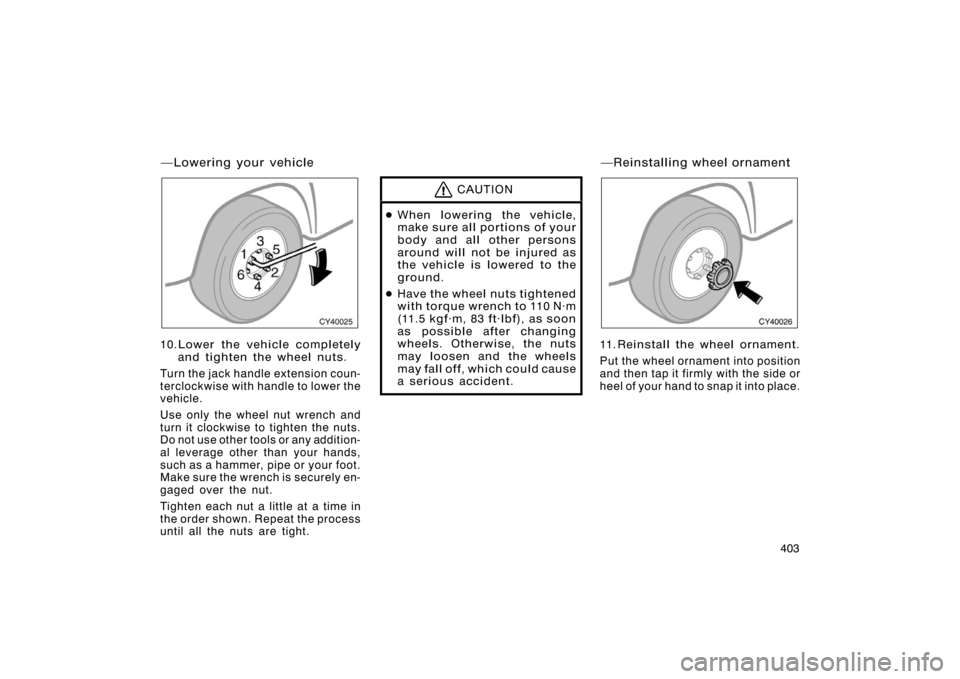Page 392 of 496

380
HITCHES
�If you wish to install a trailer hitch, you
should consult with your Toyota dealer.
�Use only a hitch recommended by the
hitch manufacturer and the one which
conforms to the total trailer weight re-
quirement.
�According to the hitch receiver type,
the maximum gross trailer weight and
hitch that can be used differs. Refer to
the above illustrations to confirm the
hitch receiver type for your vehicle.
�If you wish to install an aftermarket
hitch, the hitch must be bolted securely
to the vehicle frame and installed ac-
cording to the hitch manufactures’ in-
structions.
�The hitch ball and king pin should have
a light coat of grease.
�Toyota recommends the ball mount as-
sembly be removed when not towing to
prevent injury and to prevent damage
in the event of a rear end collision.
After removing the ball mount assem-
bly, install the grommet to the hitch to
prevent entry of dirt and mud.
CAUTION
Do not tow the vehicle using the
hooked portion of the weight carrying
hitch. The hooked portion may break
and cause serious injury or damage
to the vehicle.
NOTICE
�Do not install weight distributing
hitch to weight carrying hitch re-
ceiver because it will be damaged
your vehicle.
� Do not use axle−mounted hitches as
they can cause damage to the axle
housing, wheel bearings, wheels or
tires. Also, never install a hitch
which may interfere with the normal
function of an Energy Absorbing
Bumper, if so equipped.
CY30003
1 Trailer ball load rating
2 Ball diameter
3 Shank length
4 Shank diameter
Page 394 of 496

382
CAUTION
�If the total trailer weight exceeds
453 kg (1000 lb.), trailer brakes are
required.
�Never tap into your vehicle’s hy-
draulic system as it would lower its
braking effectiveness .
�Never tow a trailer without using a
safety chain securely attached to
both the trailer and the vehicle. If
damage occurs to the coupling unit
or hitch ball, there is danger of the
trailer wandering over into another
lane.
CY30008
SERVICE CONNECTOR FOR TOWING
BRAKE CONTROLLER
Your vehicle is equipped with a service
connector for the towing brake controller
as shown. Link the connector to the tow-
ing brake controller via the sub wire har-
ness stored in the glove box. The detailed
explanation of the sub wire harness circuit
is packed together with the sub wire har-
ness.
Be sure to position the towing brake con-
troller where it does not prevent the driver
from operating the pedal.
Toyota recommends that the sub wire har-
ness be stored in the glove box when it
is not in use. TIRES
�Ensure that your vehicle’s tires are
properly inflated. See page 441 in Sec-
tion 7−2 and page 467 in Section 8 for
instructions.
�The trailer tires should be inflated to
the pressure recommended by the trail-
er manufacturer in respect to the total
trailer weight.
Page 396 of 496

384
DISCONNECTING A TRAILER (models
with rear height control air suspension)
Stop your vehicle and a trailer in line and
perform the following:1. Put the rear height control air suspen- sion in the �LO" (low) mode. (Make
sure the vehicle height is in the �LO"
(low) mode by pushing the height se-
lect switch on the � �" side.)
2. Turn the engine switch off or push the �HEIGHT CONTROL OFF" switch to
turn off the rear height control air sus-
pension.
3. Set the supporting leg of a trailer on the ground and raise the hitch by 100
mm (4 in.).
4. Turn the engine switch on or push the �HEIGHT CONTROL OFF" switch to
turn on the rear height control air sus-
pension.
5. Wait for about 20 seconds until the rear vehicle height is lowered by the
automatic leveling function.
6. Make sure the hitch is disconnected. If not, raise the hitch higher and repeat
steps 2 through 5. 7. Move the vehicle forward in the �LO"
(low) mode where the hitch does not
touch anything in the �N" (normal)
mode.
8. Put the rear height control air suspen- sion in the �N" (normal) mode.
PRE−TOWING SAFETY CHECK
�Check that your vehicle remains level
when a loaded or unloaded trailer is
hitched. Do not drive if the vehicle has
an abnormal nose−up or nose−down
condition, and check for improper
tongue load, overload, worn suspension
or other possible causes.
�Make sure the trailer cargo is securely
loaded so that it cannot shift.
�Check that your rear view mirrors con-
form to any applicable federal, state/
provincial or local regulations. If not,
install the rear view mirrors required
for towing purpose. TRAILER TOWING TIPS
When towing a trailer, your vehicle will
handle differently than when not tow-
ing. The three main causes of vehicle−
trailer accidents are driver error, exces-
sive speed and improper trailer loading.
Keep these in mind when towing:
�Before starting out, check operation of
the lights and all vehicle−trailer connec-
tions. After driving a short distance,
stop and recheck the lights and con-
nections. Before actually towing a trail-
er, practice turning, stopping and back-
ing with a trailer in an area away from
traffic until you learn the feel.
�Backing with a trailer is difficult and
requires practice. Grip the bottom of
the steering wheel and move your hand
to the left to move the trailer to the
left. Move your hand to the right to
move the trailer to the right. (This pro-
cedure is generally opposite to that
when backing without a trailer.) Also,
just turn the steering wheel a little at
a time, avoiding sharp or prolonged
turning. Have someone guide you when
backing to reduce the risk of an acci-
dent.
Page 408 of 496

396�
Make sure to set the jack prop-
erly in the jack point. Raising
the vehicle with jack improper-
ly positioned will damage the
vehicle or may allow the ve-
hicle to fall off the jack and
cause death or serious injury.
� Never get under the vehicle
when the vehicle is supported
by the jack alone.
� Use the jack only for lifting
your vehicle during wheel
changing.
� Do not raise the vehicle with
someone in the vehicle.
� When raising the vehicle, do
not place any objects on top
of or underneath the jack.
� Raise the vehicle only high
enough to remove and change
the tire.
NOTICE
� Do not continue driving with
a deflated tire. Driving even a
short distance can damage a
tire and wheel beyond repair.
� Vehicles with rear height con-
trol air suspension: When
jacking up or installing the
tire chains, be sure to turn
off the rear height control
and stop the engine. Other-
wise, the vehicle height may
change in the automatic lev-
eling function, resulting in
accident.
CY40055
1. G et th e req u i red to o l s an d
spare tire.
1. Tool bag
2. Jack
To prepare yourself for an emergency,
you should familiarize yourself with
the use of the jack, each of the tools
and their storage locations.
When storing the tool bag, make sure
it is securely held by the tightening
strap.
�Required tools and spare
tire
Page 409 of 496
397
CY40056
Turn the jack joint by hand.
To remov e: Tur n the joint in direction
1 until the jack is free.
To store: Turn the joint in direction 2
until the jack is fi rmly secured to pre-
vent it flying forward during a collision
or sudden braking.
CY40050
To remove the spare tire under the
luggage compartment:
1. Put a jack handle and jack handle extensions together as shown in
the illustration.
1. Jack handle extensions
2. Jack handle
CY40052
When connecting the jack handle ex-
tensions, use the jack handle to tight-
en the square head bolt. Make sure
that the bolt fits into the depression
on the joint.
When connecting the jack handle ex-
tension with the jack handle, tighten
the round head bolt by hand.
NOTICE
Tighten the square head bolt
securely. Otherwise, the exten-
sion may come off and it may
damage the paint or vehicle
body.
Page 410 of 496

398
CY40047
2. Insert the end of the jack handleextension into the lowering screw
and turn it counterclockwise with
the handle.
3. After the tire is lowered completely to the ground, remove the holding
bracket.
When storing the spare tire, put it in
place with the outer side of the wheel
facing up. Then secure the tire, taking
care that the tire goes straight up
without catching on any other part, to
prevent it from flying forward during
a collision or sudden braking.
CY40011
2. Block the wheel diagonally op- posite the flat tire to keep the
vehicle from rolling when it is
jacked up.
When blocking the wheel, place a
wheel block in front of one of the front
wheels or behind one of the rear
wheels.
CY40020
3. Remove the wheel ornament.
Pry off the wheel ornament, using the
beveled end of the wheel nut wrench
as shown.
CAUTION
Do not try to pull off the orna-
ment by hand. Take due care in
handling the ornament to avoid
unexpected personal injury.
�Blocking the wheel �Removing wheel ornament
Page 412 of 496
400
CY40051
Put a jack handle, jack handle exten-
sions and jack handle end together
as shown in the illustration.
1. Jack handle end
2. Jack handle extensions
3. Jack handle
CY40052
When connecting the jack handle ex-
tension(s) and jack handle end, use
the jack handle to tighten the square
head bolt. Make sure that the bolt fits
into the depression on the joint.
When connecting the jack handle ex-
tension with the jack handle, tighten
the round head bolt by hand.NOTICE
Tighten the square head bolt
securely. Otherwise, the exten-
sion may come off and it may
damage the paint or vehicle
body.
CY40054
�����
��
��� �
��
6. After making sure that no oneis in the vehicle, as the jack
touches the vehicle and begins
to fit, double−check that it is
properly positioned.
Rear side only�
When positioning the jack under the
rear axle housing, make sure the
groove on the top of the jack fits with
the rear axle housing.
�Raising your vehicle
Page 415 of 496

403
CY40025
10.Lower the vehicle completelyand tighten the wheel nuts.
Turn the jack handle extension coun-
terclockwise with handle to lower the
vehicle.
Use only the wheel nut wrench and
turn it clockwise to tighten the nuts.
Do not use other tools or any addition-
al leverage other than your hands,
such as a hammer, pipe or your foot.
Make sure the wrench is securely en-
gaged over the nut.
Tighten each nut a little at a time in
the order shown. Repeat the process
until all the nuts are tight.
CAUTION
� When lowering the vehicle,
make sure all portions of your
body and all other persons
around will not be injured as
the vehicle is lowered to the
ground.
� Have the wheel nuts tightened
with torque wrench to 110 N·m
(11.5 kgf·m, 83 ft·lbf), as soon
as possible after changing
wheels. Otherwise, the nuts
may loosen and the wheels
may fall off, which could cause
a serious accident.
CY40026
11. Reinstall the wheel ornament.
Put the wheel ornament into position
and then tap it firmly with the side or
heel of your hand to snap it into place.
�Lowering your vehicle �Reinstalling wheel ornament